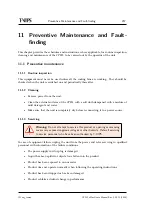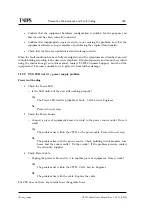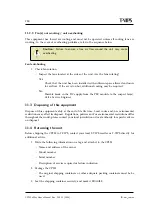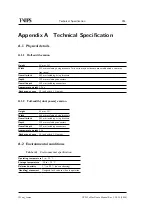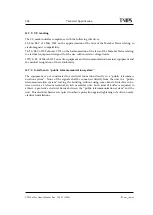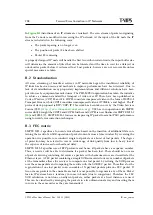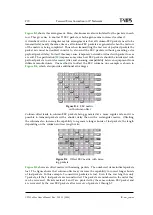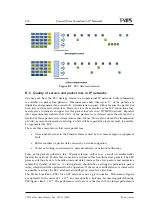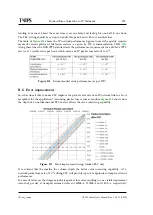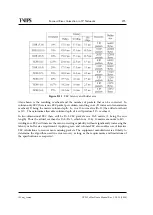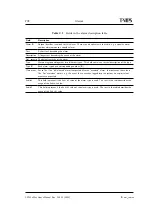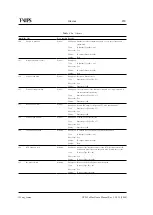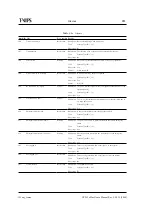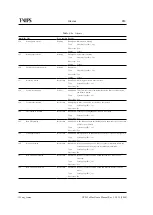
268
Forward Error Correction in IP Networks
CP525 cMux User’s Manual Rev. 5.20.12 (3944)
ID: um_tsmux
In
distortions of an IP stream are visualised. The even stream of packets originating
from the Tx node is modified in traversing the IP network. At the input of the Rx node the IP
stream is distorted in the following ways:
•
The packet spacing is no longer even
•
The position of packet #6 has been shifted
•
Packet #8 is missing
A properly designed IP node will handle the first two within certain limits; the input buffer size
will determine the amount of jitter that can be tolerated and the time to wait for a delayed or
out-of-order packet before it is deemed lost. Lost packets, however, are not recoverable unless
special measures are taken.
B.2 Standardisation
All since streaming of broadcast services in IP networks began the insufficient reliability of
IP links has been an issue, and methods to improve performance have been devised. Due to
lack of standardisation many proprietary implementations and different solutions have been
put into use by equipment manufacturers. The PRO-MPEG organisation has taken the initiative
to achieve a common standard for transport of video over IP. These have been published as
Code of Practice (COP) #3 and #4. COP#3 considers compressed video in the form of MPEG-2
Transport Stream, while COP#4 considers uncompressed video at 270Mbit/s and higher. The IP
protocol stack proposed is RTP/UDP/IP. This work has been taken over by the Video Services
Forum (VSF) (
http://www.videoservicesforum.org
). VSF has in cooperation with SMPTE
successfully brought the COP#3 and COP#4 further and COP#3 is now finalised as SMPTE 2022-1
and 2022-2
. SMPTE 2022-1 focuses on improving IP packet loss ratio (PLR) performance
using forward error correction techniques.
B.3 FEC matrix
SMPTE 2022-1 specifies a forward error scheme based on the insertion of additional data con-
taining the result of an XOR-operation of packet content across a time window. By reversing the
operation it is possible to reconstruct single lost packets or a burst of lost packets. The degree
of protection may be selected to cover a wide range of link quality from low to heavy loss at
the expense of increased overhead and delay.
SMPTE 2022-2 specifies use of RTP protocols and hence all packets have a sequence number.
Thus, a receiver will be able to determine if a packet has been lost. There should be no cases
of packets arriving containing bit errors as packets with checksum errors are discarded at the
Ethernet layer. A FEC packet containing a simple XOR-sum carried out over a number of packets
at the transmitter allows the receiver to compute one lost packet by redoing the XOR process
over the same packets and comparing the results with the XOR FEC packet. This allows for the
regeneration of one lost packet in an ensemble of N payload packets plus one FEC packet. If
two or more packets in the ensemble are lost it is not possible to regenerate any of them. Packet
loss in IP systems have a tendency to come in bursts (due to congestion). Therefore the FEC
XOR calculation is not done on adjacent packets; rather packets at a fixed distance are used.
This can be visualised by arranging the packets in a two dimensional array and inserting them
in rows in the same order as they are transmitted.
Summary of Contents for CP525 cMux
Page 2: ......
Page 10: ......
Page 12: ...12 CP525 cMux User s Manual Rev 5 20 12 3944 ID um_tsmux ...
Page 18: ...18 CP525 cMux User s Manual Rev 5 20 12 3944 ID um_tsmux ...
Page 24: ...24 CP525 cMux User s Manual Rev 5 20 12 3944 ID um_tsmux ...
Page 66: ...66 CP525 cMux User s Manual Rev 5 20 12 3944 ID um_tsmux ...
Page 238: ...238 CP525 cMux User s Manual Rev 5 20 12 3944 ID um_tsmux ...
Page 248: ...248 CP525 cMux User s Manual Rev 5 20 12 3944 ID um_tsmux ...
Page 276: ...276 CP525 cMux User s Manual Rev 5 20 12 3944 ID um_tsmux ...




